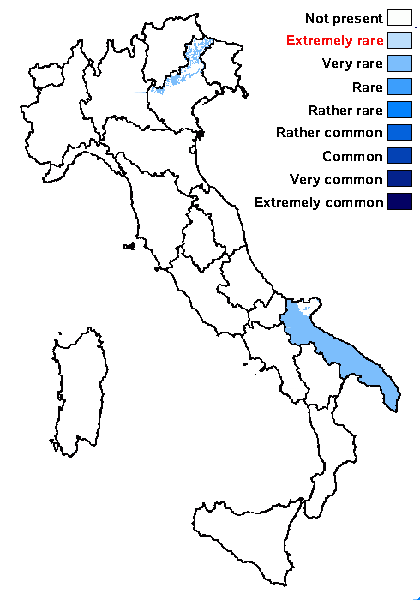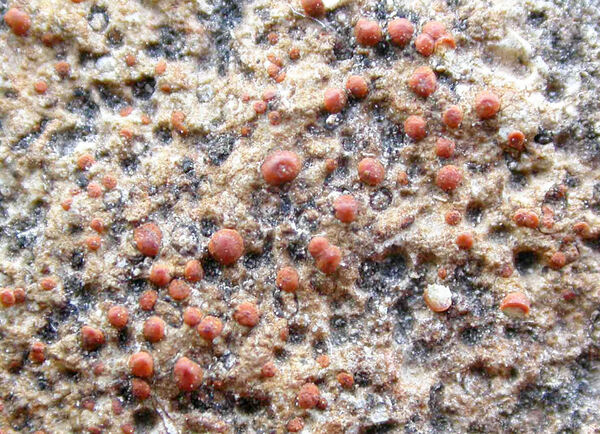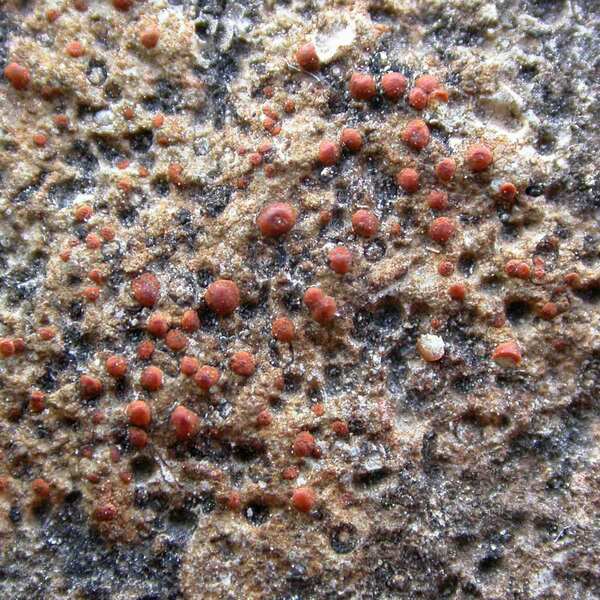Protoblastenia lilacina Poelt & Vězda
in Vezda, Cas. slezsk. Mus. Opave, A 19: 26, 1970.
Synonyms: Biatora rupestris var. sanguinea Arnold; Protoblastenia calva var. sanguinea (Arnold) Cl. Roux; Protoblastenia rupestris var. sanguinea (Arnold) Zahlbr.
Distribution: N - Ven (Kainz & Rambold 2004). S - Pugl (Kainz & Rambold 2004).
Description: Thallus crustose, endosubstratic or more rarely thinly episubstratic, continuous or finely cracked, whitish or pale grey, often inconspicuous. Apothecia 0.25-1 mm across, sessile, not constricted at base and not immersed in pits, with a convex, ochraceous orange, often pruinose disc and a very thin, soon excluded proper margin. Proper exciple poorly developed, of branched, parallel-radiating hyphae, colourless or patchily pale orange; epithecium orange-brown, 8-15 µm high, reacting K- or K+ darkening orange (never K+ deep red); hymenium colourless to pale orange, 85-120 µm high, hemiamyloid; paraphyses coherent, sparingly branched and anastomosing, 2-3 µm thick, the apical cells slightly swollen, 2-3.5 µm wide; hypothecium colourless, yellowish or often purplish red, patchily pigmented. Asci 8-spored, elongate-clavate, with a thin, outer amyloid layer and a thickened tholus penetrated by a tube, the sides of which stain I/KI+ deep blue, Porpidia-type. Ascospores 1-celled, hyaline, broadly ellipsoid to ovoid, 12-17 x 6-8 µm, without a distinct perispore. Photobiont chlorococcoid. Spot tests: thallus and apothecia K-, C-, KC-, P-; apothecia K- or K+ darkening orange. Chemistry: apothecia with unknown purplish pigments.Note: a rather poorly known species of sunny calcareous rocks below the subalpine belt, reported from Germany, France, Austria, Italy, and Croatia. It is characterised by the weak reaction of the apothecia to K.
Growth form: Crustose endolithic
Substrata: rocks
Photobiont: green algae other than Trentepohlia
Reproductive strategy: mainly sexual
Poorly known taxon in need of further study
Commonnes-rarity: (info)
Alpine belt: absent
Subalpine belt: absent
Oromediterranean belt: absent
Montane belt: very rare
Submediterranean belt: very rare
Padanian area: absent
Humid submediterranean belt: absent
Humid mediterranean belt: absent
Dry mediterranean belt: very rare

Predictive model
Herbarium samples
Growth form: Crustose endolithic
Substrata: rocks
Photobiont: green algae other than Trentepohlia
Reproductive strategy: mainly sexual
Poorly known taxon in need of further study
Commonnes-rarity: (info)
Alpine belt: absent
Subalpine belt: absent
Oromediterranean belt: absent
Montane belt: very rare
Submediterranean belt: very rare
Padanian area: absent
Humid submediterranean belt: absent
Humid mediterranean belt: absent
Dry mediterranean belt: very rare

Predictive model
| Herbarium samples |
 Index Fungorum
Index Fungorum
 GBIF
GBIF



